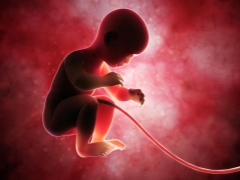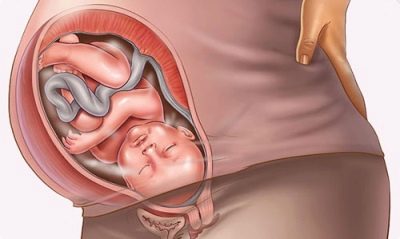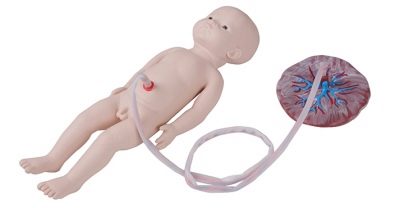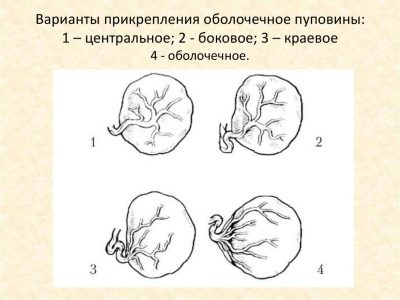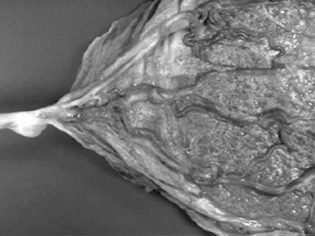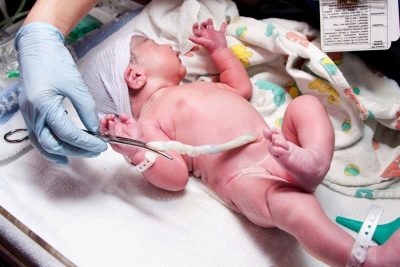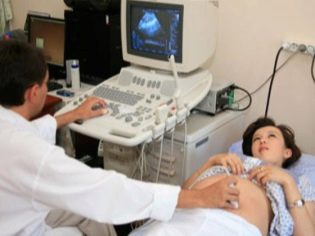Types of umbilical cord attachments and effects on the fetus
The umbilical cord is a strong and elastic cord that reliably connects the baby growing in the mother's womb with the placenta, with the mother. If the umbilical cord is healthy and does not have abnormalities in the structure, the baby receives enough oxygen and nutrients. Its development is not disturbed. However, anomalies of the umbilical cord can cause pathologies and even death of the fetus. We will explain what types of umbilical cord attachments exist, what consequences for the child they may entail, in this article.
Norm
A normal, healthy umbilical cord has three vessels: two arteries and one vein. In the vein to the baby enters the maternal blood, enriched with oxygen, vitamins, trace elements that are necessary for the growth and development of the fetus. Through the arteries back to the placenta, and from there the products of the baby’s metabolism (creatine, carbon dioxide, urea, etc.) are excreted into the maternal organism.
Normally, the umbilical cord has a length of about 50-70 centimeters. A longer umbilical cord creates the danger of entanglement and strangulation of the fetus during its active movements. A shorter one restricts the movement of the crumbs, and also represents a danger during childbirth: its tension can provoke placental abruption, bleeding and acute hypoxia of the fetus.
One side of the umbilical cord adjacent to the anterior abdominal wall of the fetus, and the other - to the placenta. Normal is considered the central attachment of the umbilical cord. When it is the umbilical cord is attached to the central part of the "children's place".
Attachment anomalies
The abnormalities in obstetrics include any structural changes in the umbilical cord cord: changes in the number of vessels, the presence of blood clots, insufficient or excessive length, as well as the presence of nodes, cysts and options for attaching the umbilical cord, which are not considered normal.
There are several types of anomalous attachment of the umbilical cord to the placenta:
- Regional. With this attachment, the cord joins with the placenta along its peripheral edge.
- Shell. With this attachment, the umbilical cord is connected to the fetal membranes.
When the marginal attachment of the vein and the two arteries that provide the vital functions of the child, are attached too close to the edge of the “children's place”. This type of attachment does not carry much danger, in most cases it is not reflected in pregnancy. Opinions of doctors regarding the regional attachment are usually similar: a woman can give birth in a natural way. Caesarean section, if no other indications for it, is required.
The only threat that can create a marginal (lateral) attachment of the umbilical cord - the wrong actions of the obstetric team during childbirth. At birth, physicians sometimes help by sipping the umbilical cord. In the case of edge fastening, such actions can lead to the separation of the cord, and the placenta will have to be removed manually.
Shell (or shell) attachment of the cord to the umbilical cord in the womb is quite rare - in about 1-1.5% of cases. The cord itself is adjacent to the membranes, which are distant from the placenta. During this very distance, the umbilical cord vessels are completely protected by nothing, they approach the placental disk directly. This is a more dangerous anomaly of the placenta than the edge of the mount.
In the case of an enveloped type, the child often develops a developmental delay syndrome (due to malnutrition and oxygen provision in the process of carrying). Such babies are often born underweight. Chronic hypoxia, which affects babies in the womb, often leads to a delay not only physical but also mental development, as well as violations of the central nervous system.
In almost 9% of cases of the development of the umbilical cord attachment, a child is diagnosed with malformations: absence of the esophagus, cleft palate, congenital dislocation of the hip, abnormal head shape, and so on.
Doctors say that the shell attachment can independently transform into normal, central, but this option is not very common.
Such an attachment is very dangerous, not even during pregnancy, but at the time of delivery. In case of violation of the integrity of the fetal bladder, the umbilical cord is torn off, which leads to bleeding and may result in death of the fetus. Doctors try to carry out delivery at such an abnormal umbilical cord by cesarean section to minimize the risks.
These two main types of umbilical anomalies are also called eccentric attachments. If the cord is attached to the umbilical cord in the central part, but slightly shifted in any direction, they speak of a paracentral mount, which is considered a variant of the norm.
The reasons
The cause of the marginal attachment of the umbilical cord is anomalies of the development of the umbilical cord during the stage of placenta formation. Most often, such an anomaly appears in women who bear the firstborn, as well as in expectant mothers who become pregnant at a fairly young age (from 18 to 23 years old).
The risk group includes pregnant women who are forced by duty or due to other circumstances to spend a lot of time on their legs, in an upright position (especially if they often experience serious physical exertion).
Last but not least among the causes of anomalous attachment of the umbilical cord are pathologies of pregnancy: polyhydramnios and low water, placenta previa, abnormal location of the fetus in the uterus. The most common regional attachment is combined with other pathologies of the umbilical cord: with nodes, a violation of the location of the vessels inside.
The reasons for the shell attachment of the umbilical cord are still not completely clear, but observations show that most often the pathology is characteristic of women who carry twins or triplets, as well as women who give birth much and often.
Genetic abnormalities of the fetus are also considered among the causes of abnormal shell (pleusity) attachment. Very often, in Down syndrome, the umbilical cord attachment is formed in a child.
Treatment
Unfortunately, medicine today can not offer a single method for the treatment of abnormal attachment of the umbilical cord to the placenta. During pregnancy, the pathology can not be eliminated by medicine, gymnastics, diets, or surgically. There is no possibility to influence the location of the umbilical cord. For this reason, doctors, diagnosing abnormalities in the location of the umbilical cord, are adopting tactics of waiting and observation.
A woman with an edge or shell attachment is recommended to visit the antenatal clinic more often, do an ultrasound more often, and at a later date - CTG to make sure that the child does not experience hypoxia. If there are signs that indicate unsuccessful fetus (disturbance of the condition and palpitations according to CTG data, delayed development on ultrasound), early delivery can be performed: by caesarean section in case of sheath or natural way with regional attachment.
If the gestation period is insufficient for doctors to be confident in the viability of the fetus (no 36 weeks), the woman is hospitalized in the hospital, where the standard preservation therapy is carried out in such cases.These are antispasmodics for relieving symptoms of uterine tone, vitamins and drugs that improve uteroplacental blood flow.
The diagnosis of “anomalous attachment of the umbilical cord” according to the regional or shell principle means not only that there will be a lot of attention to the woman from the attending physician, but also that she will have to go to the hospital before others. At 37-38 weeks, such patients are tried to be hospitalized in order to make a decision on the tactics of childbirth. In case of shell attachment, it is important not to allow spontaneous rupture of the membranes, and therefore a caesarean section is performed in advance, before the beginning of independent labor activity.
There is good news: in most cases with abnormal anchorage, if it is not accompanied by fetal malformations and genetic pathologies, as well as other umbilical cord and placenta anomalies, women safely give birth (themselves or with the help of surgeons) to perfectly normal children, and the postpartum period goes without features. It is only important to comply with all the recommendations of the doctor during gestation.
About hypoxia and entanglement of the umbilical cord of the fetus, see the following video.
